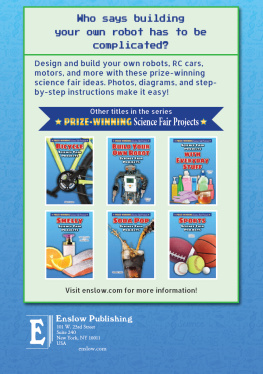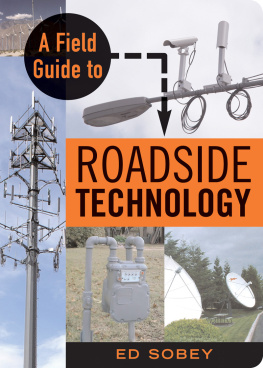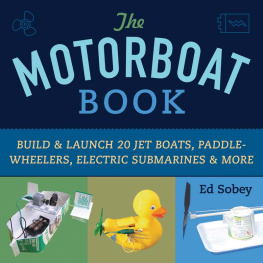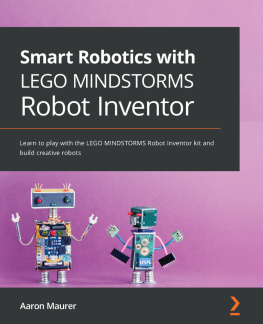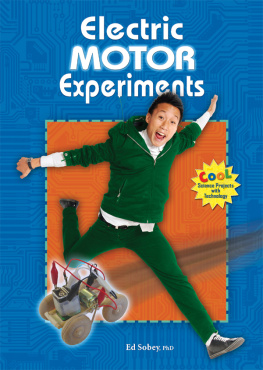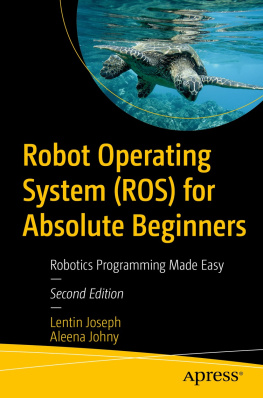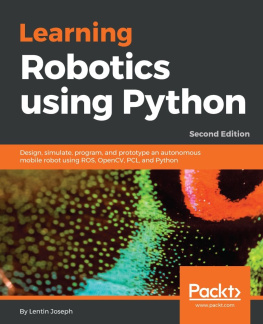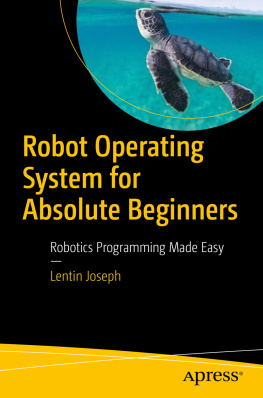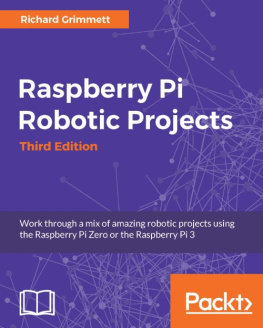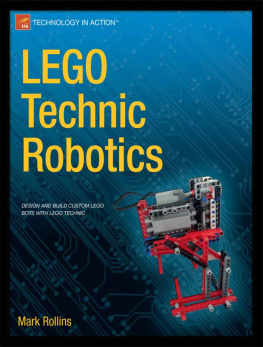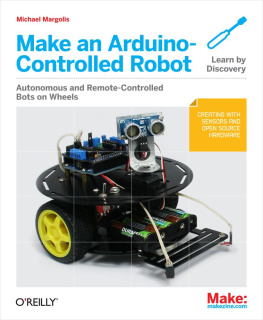Ed Sobey - Robot Experiments
Here you can read online Ed Sobey - Robot Experiments full text of the book (entire story) in english for free. Download pdf and epub, get meaning, cover and reviews about this ebook. year: 2013, publisher: Enslow Publishers, Inc., genre: Home and family. Description of the work, (preface) as well as reviews are available. Best literature library LitArk.com created for fans of good reading and offers a wide selection of genres:
Romance novel
Science fiction
Adventure
Detective
Science
History
Home and family
Prose
Art
Politics
Computer
Non-fiction
Religion
Business
Children
Humor
Choose a favorite category and find really read worthwhile books. Enjoy immersion in the world of imagination, feel the emotions of the characters or learn something new for yourself, make an fascinating discovery.
- Book:Robot Experiments
- Author:
- Publisher:Enslow Publishers, Inc.
- Genre:
- Year:2013
- Rating:4 / 5
- Favourites:Add to favourites
- Your mark:
- 80
- 1
- 2
- 3
- 4
- 5
Robot Experiments: summary, description and annotation
We offer to read an annotation, description, summary or preface (depends on what the author of the book "Robot Experiments" wrote himself). If you haven't found the necessary information about the book — write in the comments, we will try to find it.
Build your own robot! Learn what makes a robot work. Then design, build, and program your very own robot. The experiments in this book will guide you through the field of robotics. Many experiments include ideas you can use for your own science fair project.
Robot Experiments — read online for free the complete book (whole text) full work
Below is the text of the book, divided by pages. System saving the place of the last page read, allows you to conveniently read the book "Robot Experiments" online for free, without having to search again every time where you left off. Put a bookmark, and you can go to the page where you finished reading at any time.
Font size:
Interval:
Bookmark:
Building Science
How does a robot work? Using the experiments in this book, learn how to build and program your own robot. Make it sing songs, run mazes, and more! Some experiments have ideas for a fun science or technology fair project.
Robot Experiments provides a fun and informative way to introduce young readers to the scientific method using a wide variety of simple but interesting experiments about robots. After working their way through this book, readers will look at the world in a new way!
About the Author
Ed Sobey, PhD, is a scientist, lecturer, and author. He has directed five museums and has written twenty-fi ve books. He conducts workshops for science teachers and museum staff throughout the world.

Have you ever wished you had a robot to clean your room for you, or even do your homework? Perhaps youve seen Star Wars or other science fiction films in which robots display artificial intelligence. There are already cars that can parallel park by themselvesbut are they real robots? Can an everyday person build one?
There are several ways to define robot, but most people agree that a robot is a machine that can act without human direction. That is, once started, it can perform useful work on its own without receiving further instructions from a person. Of course, your toaster and refrigerator both meet that criteria, but they are not robots. So what makes a true robot?
A robot is more than a machine acting by itself. A robot must also be programmable. Your computer fits that description: its a machine that you can program. But we dont consider a computer a robot because it doesnt move itself or outside objects. Yes, it spins a CD or DVD, but it doesnt move anything externally.
Going back to the toaster, it moves stuff, mostly bread and bagels, and it is programmable. You can program it for light or dark. But its still not a robot. You cant reprogram the toaster to do anything except make toast.
So a robot is a machine that moves itself or other things. It can also act autonomously using a set of instructions called a program. The program can be changed to make the robot perform different tasks. Some robots can gather information from their environment and respond intelligently to that information.
This lengthy definition suggests a list of components required for making a robot:
- Movement requires a motor.
- Movement also requires wheels, treads, or legs.
- Acting autonomously requires an onboard computer or microprocessor.
- Detecting an environment requires sensors: light, infrared light, touch, or some other type.
- Operating the motors and the computer requires a source of power.
- Being programmable requires a way to download programs from another computereither via cable, infrared link, or wireless link.
- Being programmable also requires a computer language that both you and the robot can understand.

Robots are machines that move and are controlled by programs written on computers.
Although robots may come from science fiction, they are becoming a daily reality. Robots are used in industry to weld parts together, spray paint parts, assemble those parts, and load materials onto pallets for shipping. In some large office buildings, robots deliver and pick up the mail from each office. Increasingly, research scientists use them to explore space and ocean depths. Artists use them to create moving sculptures. Robots are showing up in more and more homes. They perform some of the jobs that people dont like to do, such as vacuuming the floor and cutting the grass.
You can run many experiments with robots, but to use these in a science fair, you need to follow some guidelines. Doing a science experiment includes making observations, measuring variables, collecting and analyzing data, researching scientific reports, and making an attractive and easy-to-understand report. Simply making a robot is not science.
Start your project by playing around with robots. This is the best way to learn. Ask yourself questions about how they operate and what they can do. As you learn more, ask better and more detailed questions. Before running the experiment, think of a possible answer, or hypothesis. The experiment can test whether your hypothesis is correct.
A good question is one that you can answer by running a test and collecting data. Place your data in a graph so people can understand what you have discovered. As you do experiments, change only one thing, or variable, at a time. For example, you could test how quickly a robot navigates a maze using both touch sensors and infrared sensors. The type of sensor should be the only thing that is different between the two robots. Test each type several times and average the data (how long it took to get through the maze). Once you start running your robot, you can come up with many different experiments to try.
Get a notebook in which you can record information about each experiment you conduct. Date each entry so that you can keep track of when you did the experiment. List the materials you use, and keep notes on what you try and what results you observe. Add sketches or photos of designs and circuits that you use.
- Do any experiments or projects, whether from this book or of your own design, under the supervision of a science teacher or other knowledgeable adult.
- Read all instructions carefully before proceeding with a project. If you have questions, check with an adult.
- Maintain a serious attitude while conducting experiments. Fooling around can be dangerous to you and to others.
- Wear approved safety goggles when you are doing anything that might cause injury to your eyes.
- Do not put your fingers or any object other than properly designed electrical connectors into electrical outlets.
Chapters 2, 3, and 4 introduce you to the different components of robots. You will experiment with these parts and learn how they work. Then you will be ready to build you own robot, starting in Chapter 5.
Robots have many different components (). Some provide energy to operate other components; some transform that energy into motion; some use energy to sense the surrounding environment and to turn motors, lights, and sound on and off. The definition presented in the first chapter suggested what components are used to make robots. Lets look at these.
Some robots use hydraulic or pneumatic motors, but we will limit our robots to electric motors. There are many different kinds of electric motors (), and you will learn which ones to use in different situations.
Mobile robots use batteries to supply power to their motors. Batteries supply direct current. Stationary robots, like those used in industry, can have alternating current motors, which get electricity from sockets. For example, your refrigerator at home gets its alternating current by plugging into a wall outlet. For this book, you will focus on direct current, or DC, motors.
If you have taken apart a motorized toy or if you have messed around with batteries and motors, you are familiar with inexpensive DC motors. Many run on voltages as low as 1.5 to 3, so a common battery or batteries can power them. These motors are inexpensive, but are not easy to use for robots. They rotate very fast: some spin as fast as 17,000 RPM (revolutions per minute). Think how fast you want the robot to travel (and still be able to control it). Any reasonable speed would require the wheels to turn much slower, maybe 100 RPM. To control the speed of the inexpensive motor, you either have to vary the current that powers the motor or you need to power the wheels through a set of reduction gears that slow the speed of rotation. In most robots, both approaches are used.
Font size:
Interval:
Bookmark:
Similar books «Robot Experiments»
Look at similar books to Robot Experiments. We have selected literature similar in name and meaning in the hope of providing readers with more options to find new, interesting, not yet read works.
Discussion, reviews of the book Robot Experiments and just readers' own opinions. Leave your comments, write what you think about the work, its meaning or the main characters. Specify what exactly you liked and what you didn't like, and why you think so.


